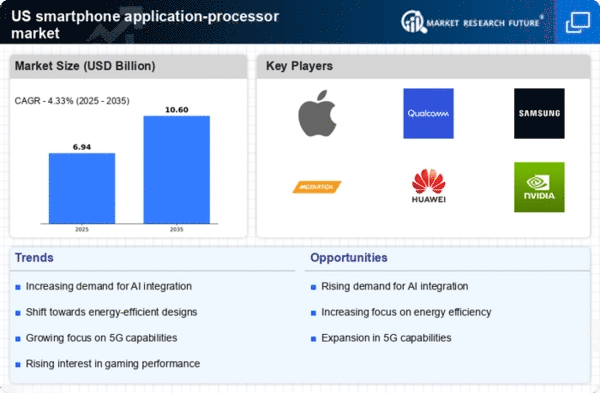Expansion of 5G Technology
The rollout of 5G technology significantly impacts the smartphone application-processor market, as it necessitates processors capable of handling increased data speeds and connectivity. With 5G expected to cover over 50% of the US population by the end of 2025, the demand for smartphones equipped with advanced application processors is likely to rise. These processors must support enhanced features such as low latency and high bandwidth, which are essential for applications like augmented reality and high-definition streaming. As a result, manufacturers are investing heavily in research and development to create processors that can leverage the benefits of 5G, thus propelling growth in the smartphone application-processor market.
Surge in Mobile Gaming Demand
The smartphone application-processor market experiences a notable surge in demand driven by the increasing popularity of mobile gaming. As gaming applications become more sophisticated, they require advanced processing capabilities to deliver high-quality graphics and seamless performance. In 2025, the mobile gaming sector is projected to generate revenues exceeding $100 billion in the US, indicating a robust growth trajectory. This trend compels manufacturers to innovate and enhance their application processors, ensuring they can support demanding gaming applications. Consequently, the smartphone application-processor market will likely see heightened competition as companies strive to develop processors that cater to the evolving needs of gamers, driving overall market growth..
Adoption of Advanced AI Features
The smartphone application-processor market is witnessing a significant shift due to the adoption of advanced AI features in mobile devices. As consumers increasingly seek personalized experiences, application processors must integrate AI capabilities to enhance functionalities such as photography, voice recognition, and user interface interactions. By 2025, it is projected that nearly 60% of smartphones will incorporate AI-driven features, necessitating the development of processors that can efficiently handle AI workloads. This trend not only drives innovation within the smartphone application-processor market but also compels manufacturers to invest in specialized AI processing units, thereby fostering a competitive landscape focused on technological advancement.
Growing Demand for Enhanced Security Features
The smartphone application-processor market is significantly impacted by the growing demand for enhanced security features in mobile devices. As cybersecurity threats become more prevalent, consumers and businesses alike prioritize devices that offer robust security measures. In 2025, it is anticipated that over 40% of smartphone users in the US will consider security features as a critical factor in their purchasing decisions. This trend drives manufacturers to develop application processors that incorporate advanced security protocols, such as biometric authentication and secure enclaves. As a result, the smartphone application-processor market is likely to evolve, with a focus on integrating security features that meet the expectations of increasingly security-conscious consumers.
Consumer Preference for High-Performance Devices
The smartphone application-processor market is influenced by a growing consumer preference for high-performance devices. As users increasingly rely on smartphones for multitasking, gaming, and productivity, the demand for processors that can deliver superior performance is on the rise. In 2025, it is estimated that over 70% of smartphone users in the US prioritize processing power when selecting a device. This trend encourages manufacturers to focus on developing application processors that offer enhanced speed and efficiency. Consequently, the smartphone application-processor market is likely to see a shift towards more powerful processors, which could lead to increased sales and market share for companies that successfully meet these consumer demands.
















Leave a Comment